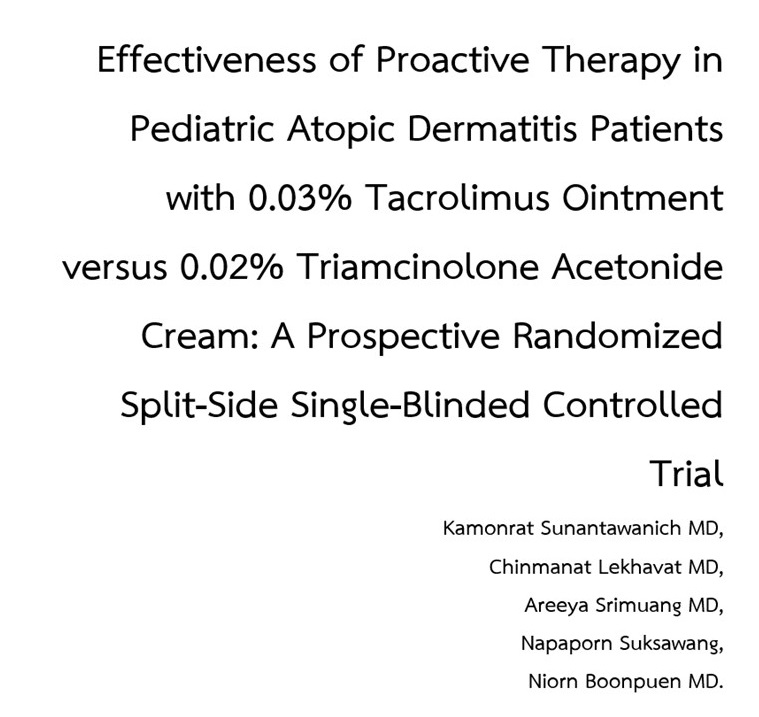Effectiveness of Proactive Therapy in Pediatric Atopic Dermatitis Patients with 0.03% Tacrolimus Ointment versus 0.02% Triamcinolone Acetonide Cream: A Prospective Randomized Split-Side Single-Blinded Controlled Trial
Keywords:
atopic dermatitis, proactive therapy, tacrolimus ointment, triamcinolone acetonide creamAbstract
Background: Along with reactive treatment aiming to control disease flares, atopic dermatitis (AD) patients can use proactive treatment to halt subclinical inflammation of normal-appearing skin and prevent exacerbation.
Objectives: To determine and compare the effectiveness and adverse effects of 0.03% tacrolimus ointment and 0.02% triamcinolone acetonide (TA) cream twice weekly as proactive therapy.
Materials and Methods: This 4-month prospective single-blinded randomized controlled trial included thirty-eight patients, aged 2-14 years old, with moderate AD (SCORAD 25-50). In the first two months, the patients applied a cream base twice daily and 0.02% TA cream as reactive therapy. In the next two months, 0.03% tacrolimus ointment and 0.02% TA cream were additionally given as proactive therapy to be applied twice weekly at selected normal-appearing areas on each side, randomly assigned between left and right sides of the antecubital or popliteal fossae. The patients were evaluated every four weeks. Outcome measures included number of disease exacerbations, disease-free days, duration to first exacerbation, and adverse effects.
Results: Thirty-eight patients completed the study. In contrast to 0.02% TA, twice weekly 0.03% tacrolimus ointment helped to reduce the number of disease exacerbations with a p-value of 0.029 and increased the total number of disease-free days by 1.5 days (p = 0.02). Both agents as proactive treatment significantly delayed the next disease flare. No adverse reaction was reported during the study.
Conclusion: We suggest using proactive therapy with 0.03% tacrolimus ointment in moderate AD patients, while 0.02% TA cream may be considered in cases of limited budget.
References
Wollenberg A, Barbarot S, Bieber T, Christen-Zaech S, Deleuran M, Fink-Wagner A, et al. Consensus-based European guidelines for treatment of atopic eczema (atopic dermatitis) in adults and children: part I. J Eur Acad Dermatol Venereol 2018;32:657-82.
Eichenfield LF, Tom WL, Berger TG, et al. Guidelines of care for the management of atopic dermatitis section 2. Management and treatment of atopic dermatitis with topical therapies. J Am Acad Dermatol 2014;71:116-32.
Chittock J, Brown K, Cork MJ, Danby SG. Comparing the effect of a twice-weekly tacrolimus and betamethasone valerate dose on the subclinical barrier defect in atopic dermatitis. Acta Derm Venereol 2015;95:653-8.
Schmitt J, von Kobyletzki L, Svensson A, Apfelbacher C. Efficacy and tolerability of proactive treatment with topical corticosteroids and calcineurin inhibitors for atopic eczema: systematic review and meta-analysis of randomized controlled trials. Br J Dermatol 2011;164:415-28.
Ngamjarus C, Chongsuvivatwong V, McNeil E. n4Studies: Sample Size Calculation for an Epidemiological Study on a Smart Device. Siriraj Med J [Internet]. 2016 Jun. 9 [cited 2022 May 28];68:160-Available from: https://he02.tci-thaijo.org/index.php/sirirajmedj/article/view/58342.
Thaci D, Chambers C, Sidhu M, Dorsch B, Ehlken B, Fuchs S. Twice-weekly treatment with tacrolimus 0.03% ointment in children with atopic dermatitis: clinical efficacy and economic impact over 12 months. J Eur Acad Dermatol Venereol 2010;24:1040-46.
Hanifin JM,Rajka G. Diagnostic features of atopic dermatitis. Acta Derm Venereol Suppl (Stockh) 1980;92:44–7.
Thaçi D, Reitamo S, Gonzalez Ensenat MA, et al. Proactive disease management with 0.03% tacrolimus ointment for children with atopic dermatitis: results of a randomized, multicenter, comparative study. Br J Dermatol 2008;159:1348-56.
Mudaliyar VR, Pathak A, Dixit A, Kumar SS. An Open-Label Prospective Study to Compare the Efficacy and Safety of Topical Fluticasone Versus Tacrolimus in the Proactive Treatment of Atopic Dermatitis. Dermatol Pract Concept 2020;26;10:e2020094.
Wollenberg A, Reitamo S, Girolomoni G, et al. Proactive treatment of atopic dermatitis in adults with 0.1% tacrolimus ointment. Allergy. 2008;63:742-50.
Siegfried EC, Jaworski JC, Kaiser JD, Herbert AA. Systematic review of published trials: long-term safety of topical corticosteroids and topical calcineurin inhibitors in pediatric patients with atopic dermatitis. BMC Pediatr 2016;16:75.

Downloads
Published
How to Cite
Issue
Section
License
Copyright (c) 2022 Thai Journal of Dermatology

This work is licensed under a Creative Commons Attribution-NonCommercial-NoDerivatives 4.0 International License.
เนื้อหาและข้อมูลในบทความที่ลงตีพิมพ์ในวารสารโรคผิวหนัง ถือเป็นข้อคิดเห็นและความรับผิดชอบของผู้เขียนบทความโดยตรงซึ่งกองบรรณาธิการวารสาร ไม่จำเป็นต้องเห็นด้วย หรือร่วมรับผิดชอบใดๆ
บทความ ข้อมูล เนื้อหา รูปภาพ ฯลฯ ที่ได้รับการตีพิมพ์ในวารสารโรคผิวหนัง ถือเป็นลิขสิทธิ์ของวารสารฯ หากบุคคลหรือหน่วยงานใดต้องการนำทั้งหมดหรือส่วนหนึ่งส่วนใดไปเผยแพร่ต่อหรือเพื่อกระทำการใดๆ จะต้องได้รับอนุญาตเป็นลายลักอักษรจากบรรณาธิการวารสารโรคผิวหนังก่อนเท่านั้น


